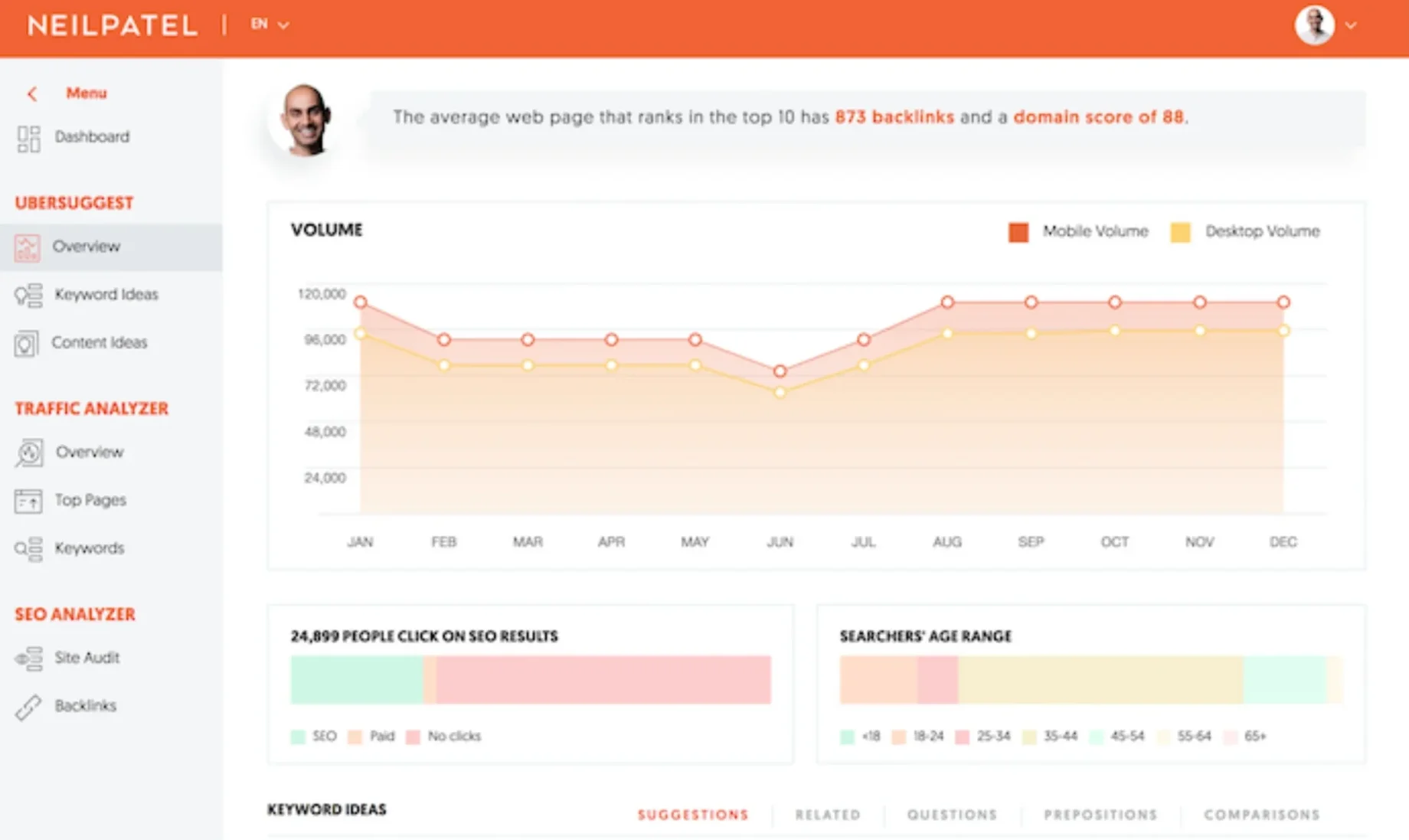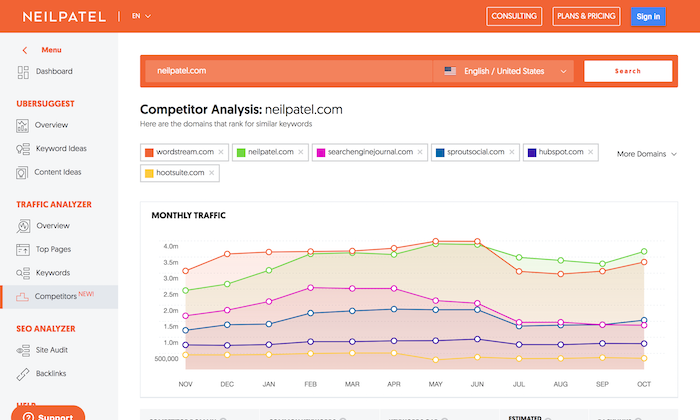Ubersuggest.com: How to Navigate the Platform for Maximum SEO Results

A step-by-step guide to mastering Ubersuggest.com’s interface. Unlock hidden features to boost your website’s rankings and outpace competitors.
Are you tired of seeing your competitors dominate search engine results pages (SERPs)? Do you feel overwhelmed by the sheer number of SEO tools available, unsure which one will deliver the best return on investment for you? At Growth-Metric, we’ve personally used and vetted numerous tools, and we consistently find Ubersuggest.com to be incredibly effective for businesses of all sizes. This comprehensive guide will teach you how to navigate Ubersuggest.com to achieve maximum SEO results, providing a detailed step-by-step approach to unlock its hidden potential and gain a competitive edge.
Tool Stack Essentials
While Ubersuggest is a powerful standalone tool, integrating it with other platforms significantly amplifies its effectiveness. Here’s a suggested tool stack for optimal SEO performance:
Ubersuggest: Our primary recommendation for keyword research, competitor analysis, and backlink tracking. Its user-friendly interface makes it accessible to beginners, while its sophisticated features cater to experienced SEO professionals.
Google Search Console (GSC): Essential for monitoring website performance, identifying technical SEO issues, and submitting sitemaps. GSC provides invaluable data unavailable in Ubersuggest for free.
Google Analytics (GA): Crucial for tracking website traffic, user behavior, and conversion rates. It provides the context and validation for the insights gleaned from Ubersuggest when optimizing for target keywords.
SEMrush (Alternative): A comprehensive SEO suite offering similar functionalities to Ubersuggest, though at a higher price point. Consider SEMrush if your budget allows for a more extensive feature set.
Ahrefs (Alternative): Another robust competitor to Ubersuggest known for its in-depth backlink analysis capabilities. Ahrefs comes with a premium price tag appropriate only for those that need extensive deep-dive capabilities from this single tool.
This integrated approach ensures a holistic view of your SEO strategy, maximizing your chances of success.
Table of Contents
Don’t optimize for conversions, optimize for revenue.
Implementation Timeline
Implementing Ubersuggest effectively typically involves a phased approach:
Phase 1: Setup (1-2 days): Create a Ubersuggest account, connect your website, and familiarize yourself with the interface. This involves setting up your website profile and inputting appropriate data for the most accurate results.
Phase 2: Keyword Research & Competitor Analysis (1 week): Identify high-volume, low-competition keywords relevant to your business. Analyze your top competitors’ strategies using Ubersuggest’s competitor analysis feature. This is crucial for understanding the SEO landscape for the target set of keywords.
Phase 3: On-Page Optimization (2-4 weeks): Optimize your website content, meta descriptions, and title tags based on your keyword research. This may include updates to your content and ongoing tracking through the chosen tools.
Phase 4: Off-Page Optimization (Ongoing): Build high-quality backlinks, focusing on relevant and authoritative websites. Monitor progress using the tool’s backlink tracking feature. This is vital for maintaining an adequate SEO profile and requires consistent monitoring.
ROI: Ubersuggest empowers you to identify highly-targeted opportunities for maximum impact. While immediate results vary by industry and starting point, many users report a 2x to 3x improvement in organic traffic within 3-6 months of consistent implementation.
Step-by-Step Guide to Mastering Ubersuggest.com
Here’s a detailed step-by-step walkthrough of how to leverage Ubersuggest for optimal SEO outcomes:
### Step 1: Keyword Research
Navigate to the “Keyword Ideas” section. Enter a seed keyword relevant to your business. Ubersuggest provides a wealth of keyword suggestions, complete with search volume, competition, and related keywords. Analyze this data to pinpoint high-potential keywords with manageable competition.
### Step 2: Competitor Analysis
Use the “SEO Explorer” tab to analyze your top competitors’ website and SEO strategies. Examine their top-performing keywords, organic traffic, backlinks, and content strategy. This provides invaluable insights into their successful tactics and can help understand what can work for you.
### Step 3: Content Optimization
Leverage Ubersuggest’s insights to create high-quality content optimized for your target keywords. Pay close attention to title tags, meta descriptions, and header tags (H1-H6). This is critical for improving organic search results.
### Step 4: Backlink Analysis
Ubersuggest’s backlink checker helps determine which sites link to your competitors and which may be suitable to build backlinks toward your site for increased SEO. It allows identifying opportunities for building high-quality backlinks to your website.
### Step 5: Website Audit
Use the “Site Audit” features to identify any technical issues that might be hindering your website’s SEO performance such as broken links, slow loading times or thin content. Fixing these problems is essential for improving your website’s SEO results.
### Step 6: Track Keyword Rankings
Monitor your website’s keyword rankings over time for specific keywords and related phrases. Ubersuggest’s Rank Tracker helps gauge the improvements on your SEO results. This allows evaluating the effect of your SEO strategies.
### Step 7: Report Generation
Ubersuggest creates useful reports which allow you to visualize your progress as well as share your insights as needed.

Key Metrics to Track
To measure the success of your Ubersuggest-driven SEO strategy, track these key metrics:
- Organic Traffic: The number of visitors coming to your website from organic search results. This is a key indication that your strategy is working and that your website is showing progress compared to competitors.
- Keyword Rankings: The position of your website in search engine results pages (SERPs) for specific keywords. Tracking your rankings for various keywords is crucial for evaluating organic search results.
- Backlinks: The number of high-quality websites linking to your website. This allows you to gauge improvements in overall SEO standing.
- Domain Authority: A score reflecting the influence of your site and authority on search engine results pages. Improvement on your Domain Authority is a good sign.
- Conversion Rates: The percentage of website visitors who complete a desired action (e.g., sign up for a newsletter, make a purchase). This key metric demonstrates SEO efficiency and improvement on conversion rates from your website visitors.
Budget-Friendly Alternatives
For startups or bootstrapped teams with limited resources, consider these cost-effective alternatives:
- Ubersuggest’s Free Plan: While limited in features, it’s an excellent starting point for basic keyword research and competitor analysis.
- Google Keyword Planner: A free tool providing keyword ideas and search volume data, though lacking the sophisticated features of Ubersuggest.
- Free SEO tools: Many websites offer free SEO tools such as SEMrush, Ahrefs and Moz for a limited time. These could be used as a cost-effective solution to evaluate your SEO.
These free alternatives lack some of Ubersuggest’s advanced features but offer a viable starting point during those early stages of growth.
Serving Your Growth Goals
Adapting Ubersuggest to different business needs is straightforward. For example:
- E-commerce Businesses: Focus on product-specific keywords, competitor analysis of similar stores, and optimizing product pages for conversions.
- Local Businesses: Incorporate location-based keywords to attract local customers. Focus on local directory optimization using tools coupled with Ubersuggest.
- Content Creators: Prioritize keywords related to your niche and audience. Monitor content performance using Analytics and Ubersuggest to optimize for various related keyword queries.
- Startups: Begin with basic keyword research, focusing on low-competition keywords. Leverage the free plan and gradually upgrade when resources allow.
Common Mistakes to Avoid
- Keyword Stuffing: Avoid overusing keywords in your content, which can damage your website’s SEO ranking.
- Ignoring Technical SEO: Neglecting website speed, mobile optimization and other technical aspects impedes Ubersuggest’s effectiveness.
- Neglecting Backlink Building: Underestimating the importance of high quality links in building authority diminishes your success potential.
- Tool Overload: Focusing too many tools and neglecting the core actions from the tools that you use would result in a less efficient use of the time and your resources.
Address these issues proactively to avoid hindering your progress and ensure maximum efficiency.
Scaling Strategies
To scale your SEO efforts, consider these advanced strategies:
- Automate repetitive tasks: Use automation tools to streamline processes like backlink tracking and rank monitoring.
- Team training and collaboration: Ensure your team utilizes Ubersuggest effectively, and establish processes for shared keyword research.
- A/B testing: Experiment with different title tags, meta descriptions, and content approaches to discover what works best for your audience.
- Data-driven decision making: Use Ubersuggest’s data to inform your SEO strategy, focusing on the most effective approaches for improving visibility.
Scaling based on a data-driven approach allows improving your efficiency with your time and resources.
Conclusion
Mastering Ubersuggest.com is key to achieving significant SEO success. By following the steps in this comprehensive guide, leveraging complementary tools, and tracking key performance indicators, you can effectively optimize your website for search engines and outpace your competitors. Download our free SEO Audit Checklist to begin your optimization journey today! [Link to Checklist]
FAQs
Q: Which tool is best for early-stage startups? A: Ubersuggest’s free plan or its affordable paid version, combined with Google Search Console and Google Analytics, provides an excellent starting point.
Q: How to prioritize tool spending? A: Prioritize tools directly impacting revenue generation and traffic. Start with free tools and then, as your budget expands, gradually invest in more advanced features like those found in the paid version of Ubersuggest.
Q: How can I improve my domain authority using Ubersuggest? A: Monitor backlinks and build those using Ubersuggest to identify websites that are high in authority.
Q: Can I use Ubersuggest for local SEO? A: Yes, Ubersuggest can be highly effective for local SEO. You can target location-based keywords and track your performance for specific locations. Use the competitive analysis feature to study local competitors.
By addressing these FAQs and utilizing the steps above, we hope to ensure you are successfully able to optimize your Ubersuggest performance.
